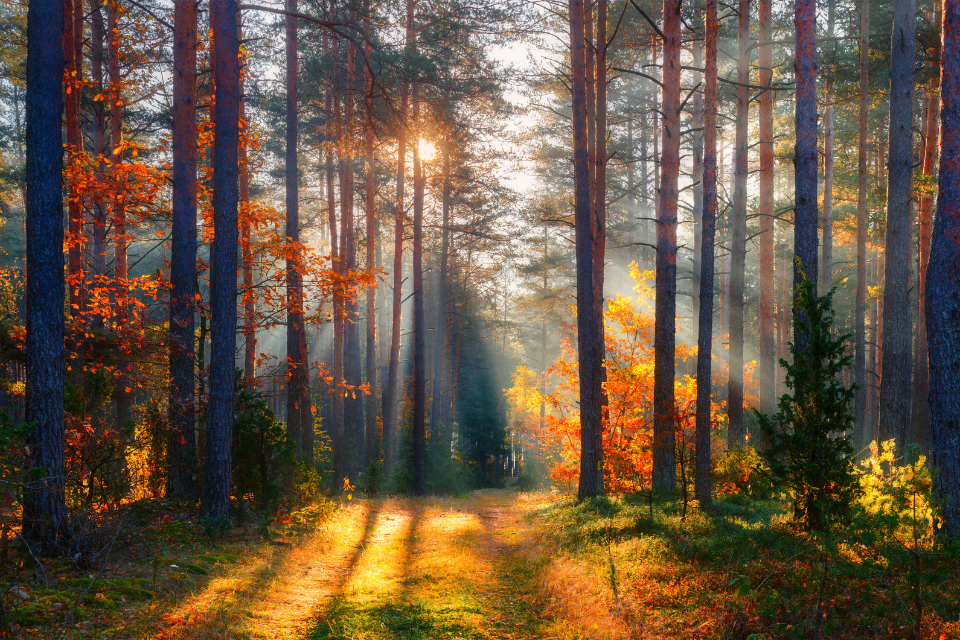The Japanese term is shinrin-yoku, which translates to “forest immersion” or “forest bathing.” In English, it’s often called “forest therapy” or “nature therapy,” but “forest bathing” is popular enough to have put an International Forest Bathing Day on the calendar (September 10 in 2022).
By any name, it’s proven medicine against the stresses of an overly “civilized” world. When you’re exhausted from overwork or reeling from tragedy, forest bathing—taking long, slow walks outdoors in a natural setting—is known to lower blood pressure, strengthen the immune system, nurture creativity, improve sleep, and reduce anxiety. Surrounding yourself with living, growing plants even provides natural aromatherapy and immunotherapy.
Just two hours a week (or half an hour every other day) will change your health and quality of life for the better. If you don’t have a literal forest available, almost any green space with reduced human traffic will do: Google “parks near me” or check your favorite maps/recreation app.
And if you read the tips below and feel you need additional help, look up “forest bathing/forest therapy guides” (that’s a human job title) for individualized instruction in getting started.

Know How to Prepare
Of course you’ll want to check the weather, dress appropriately, have adequate water and sunscreen, and take precautions against getting lost. What you don’t want to do is turn this into an “achievement” activity. Limit your itinerary to time and location, and go in prepared to let the experience happen to you, without your trying to control it. And leave all reading, work, and recorded music behind. (Going with a friend or two is fine—just remember to keep conversation limited and focused on the experience.)
Go Slow
Remember that the name is “forest bathing,” not “forest showering.” Showers are for efficiency; baths are for relaxation and immersive experience. You can’t get the full benefits of nature immersion by running, jogging, or even walking briskly: you have to amble, stopping frequently to soak up the outdoor atmosphere. (Remember to breathe deeply as well.) You’ll be surprised how long and satisfying thirty minutes can be in the absence of haste.
Use All Your Senses
“Mindfulness” is the keyword: take time to fully notice everything around you.
- See the colors and shapes of nature; the way the animals move; the shadows the trees make. Keep your head up and let it look in all directions.
- Hear the birdsong, the rustling of leaves, the sound of running water.
- Smell the bark and the blossoms.
- Feel the sun, the wind, the crunch of twigs underneath your feet.
Be an Active Observer
As part of really noticing your surroundings, feel free to note items of interest and to ask questions. (Where’s the squirrel going with that nut? What made the holes in those leaves? How many colors do wildflowers come in?) Don’t, however, feel you have to answer those questions—and remember that pulling out your smartphone to Google anything is a major “no-no” for forest bathers. Don’t even take pictures: give your technological side the full benefit of this time off. Allow yourself the chance to learn what your senses and conscious mind can collect on their own.
When Necessity Requires Modifying the Experience
If you don’t think you have any real nature trails handy, ask your local parks department or Audubon Society before you give up the idea. If you’re definitely limited to your own backyard or a small pocket park, you can still get nature-immersion benefits by just sitting and soaking up the atmosphere (preferably at a time when both motor and foot traffic are limited).
If your outdoor options are seriously limited (the weather is prohibitive, you live in an inner-city apartment without a tree for miles, you’ve got no transportation, you’re sick and completely homebound), there’s one other possibility: create a “virtual forest bathing” experience indoors. It shouldn’t be used as an excuse for avoiding the real thing, but it does help you destress.
- Download a slow-paced nature video to your largest available screen (this is no time to limit your field of view to smartphone size), and/or hang up posters with relaxing nature images (as large and realistic as possible).
- Put on a recording of nature sounds (flowing water, birdsong, etc.—no human-produced music).
- Set out some fresh flowers—preferably wildflowers from your area—mixed with leaves and other greenery. (Choose plants with strong natural aromas.) Better yet, bring in houseplants as a permanent addition to your home environment.
- Let in all the natural light your windows will allow. If the weather is appropriate and the outside air reasonably fresh, open the windows to the air.
- Seat yourself near a window.
- Watch as much of the real outdoors as you can see (even from a high-rise apartment facing a blank wall, there’ll be pigeons flying by, a green sprig peeking from a crack, clouds drifting across the sky, or the sun “drawing” patterns on the windowsill).
- Relax and observe for at least half an hour. With any luck, the experience will awaken fresh appreciation for nature—and fresh ideas for planning an outdoor forest-bathing experience!
See also:
- BridgingApps-recommended apps related to the outdoors
- Picture This—Plant Identifier app
- Weather apps
- Relaxation and mindfulness apps

